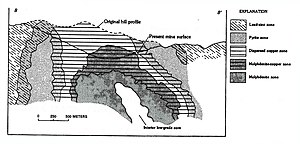The Taranis Thor Project has proven Epithermal Zones of high-grade Ag, Au, Zn, Pb & Cu (+ lots of critical minerals), ferrous gossens and is visible at surface, and has modelled the potential porphyry intrusion(s) shown on website, and was discovered in the 1890s: https://taranisresources.com/ [see bottom for description]
The monster pit @ Bingham Canyon Mine, Utah:
The Bingham Canyon Mine, more commonly known as Kennecott Copper Mine among locals,[3] is an open-pit mining operation extracting a large porphyry copper deposit southwest of Salt Lake City, Utah, in the Oquirrh Mountains. The mine is the largest man-made excavation, and deepest open-pit mine in the world,[4][5] which is considered to have produced more copper than any other mine in history – more than 19,000,000 short tons (17,000,000 long tons; 17,000,000 t). "Minerals, in the form of copper ore, were first discovered in Bingham Canyon in 1848 by two brothers, Sanford and Thomas Bingham" "Bingham Canyon has proven to be one of the world's most productive mines. As of 2004, its ore yielded more than 17 million tons (15.4 Mt) of copper, 23 million ounces (715 t) of gold, 190 million ounces (5,900 t) of silver, and 850 million pounds (386 kt) of molybdenum. The value of the resources extracted from the Bingham Canyon Mine is greater than the Comstock Lode, Klondike, and California gold rush mining regions combined." https://en.wikipedia.org/wiki/Bingham_Canyon_Mine#:~:text=Minerals%2C%20in%20the%20form%20of,who%20grazed%20their%20cattle%20there.
Geology

Cross-section through open pit, showing ore zonation

Geologic map showing bedrock geology and alteration zones, USGS.
The Bingham Canyon ore deposits occur in the Bingham nappe. They are a porphyry copper deposit, formed by a quartz monzonite porphyry intruded into sedimentary rocks. They exhibit a concentric alteration pattern and mineralogic zonation around the Bingham stock. These zones include a central core containing magnetite, followed by "a molybdenite zone low in copper, a bornite-chalcopyrite-gold higher grade copper zone, a pyrite-chalcopyrite zone, a pyrite zone, and an outermost lead-zinc zone."[18]:E1,E8
Structurally, Late Paleozoic rocks were thrust faulted over the Precambrian craton during the Cretaceous Sevier orogeny. These rocks were later intruded and altered in the Tertiary by granitoid rocks. This igneous event was the source of deposition of gold, silver and other base metals.[18]:E4
Copper and molybdenum sulfide minerals are dispersed in the intruded stock and in the adjoining carbonate sedimentary skarns. The main stratigraphic rocks in Bingham Canyon are Upper Pennsylvanian sandstones, quartzites, and limestones known as the Bingham Mine Formation in the Oquirrh Group. The central porphyry ores formed from mantle hydrothermal circulation while the outer vein and deposits in the sedimentary rocks formed at lower temperature when magmatic and meteoric waters mixed.[18]
THOR:
| The identification and implementation of a linked epithermal-porphyry geological model at Thor suggests that the +2km long existing epithermal deposit is related to a much larger source that remains undiscovered, and concealed below the surface - Namely a porphyry body such as that found at the Max mine located 8km to the southwest. The porphyry bodies are commonly mineralized in British Columbia with valuable metals.
On the right side you will find a schematic cross-section of the Thor deposit. Click on the hotspots to see photographs of the rock types and alteration that are associated with the deposit. | |
| | The Thor epithermal deposit overlies a large magnetic feature and conspicuous 'donut' in the conductivity models derived from the airborne MT survey. Based on this information, Taranis has been able to identify a large target that underlies the epithermal deposit that is believed to be related to an intrusive body that is not exposed at surface.
The Jowett Formation is highly altered around this feature and includes epidotization, albitization and is highly magnetic - all signs of alteration related to an underlying intrusive body. Click on the image to see it in more detail. |
Thor Project Highlights
- 100%-owned, capitalizing on 17 years of successful exploration, with near & long-term catalysts for growth. 27 Crown Grant Mining Claims with surface rights over the main epithermal Mineral Resource and a possible underlying concealed porphyry deposit.
- Received a 10,000 tonne Bulk Sample Permit in June of 2021 to operate a modern Gekko InLine Pressure Jig plant that will produce a pre-concentrate onsite used to characterize the polymetallic deposit, and be subsequently sent to a hydrometallurgical plant in Montana for upgrading prior to smelting.
- The Thor epithermal deposit is high-grade and near surface, defined with over 250 drill holes and is still open to the north end of the deposit.
- Taranis believes the Thor project hosts a unique type of porphyry copper deposit called a "DASH" deposit. These deposits are hosted entirely within sedimentary rocks, and have a very unique type of alteration unlike volcanic-hosted porphyry deposits worldwide. Evidence for this exists in the nearby Max molybdenum deposit that is entirely hosted within sedimentary rocks, and other famous examples include Bingham Canyon in Utah, USA.
- DASH deposits could be the answer to British Columbia's long-awaited problem that will lead to the discovery of new porphyry deposits, in areas that are easily accessible and have existing infrastructure.